



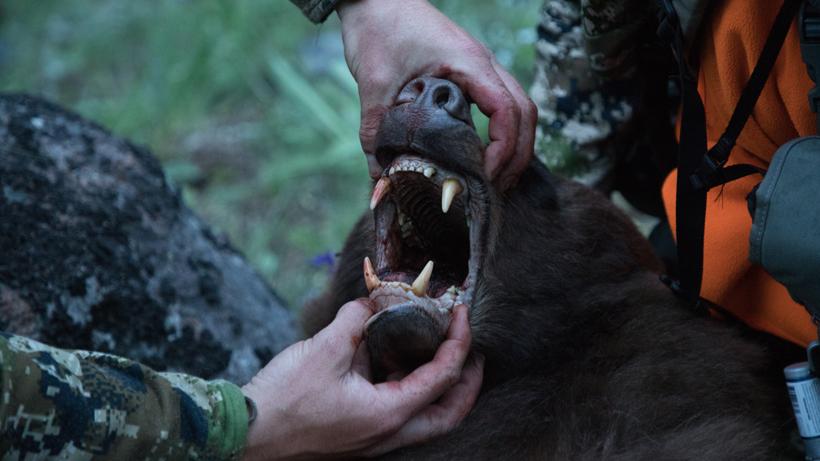
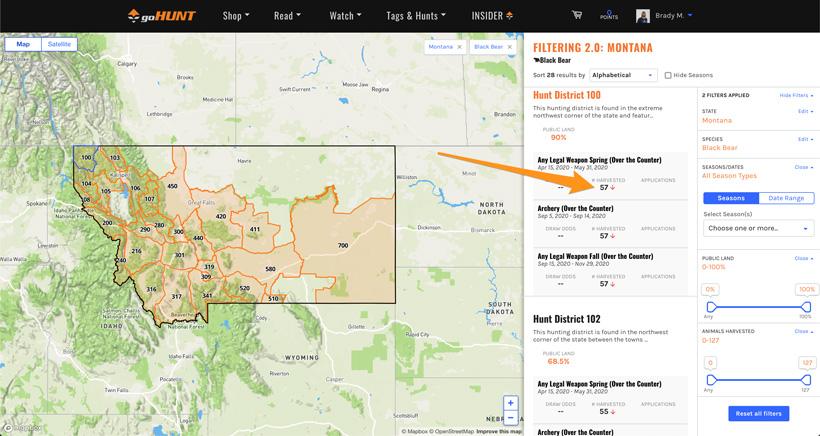
Screenshot from goHUNT's Filtering 2.0 showing the number of bears harvested in Montana.

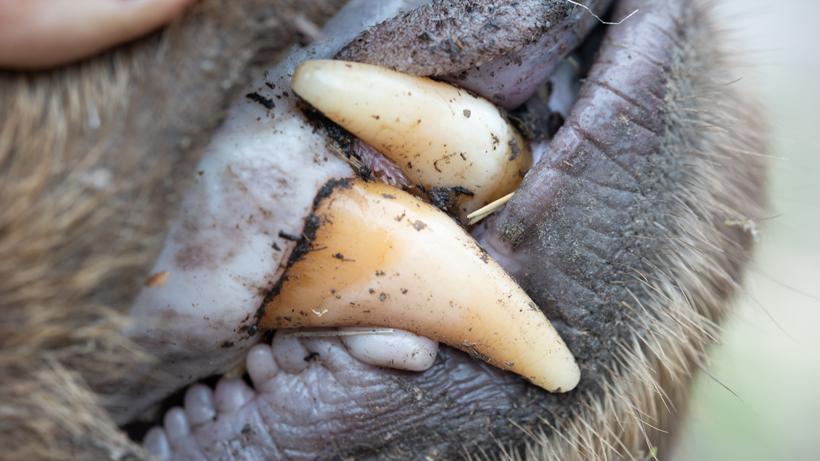
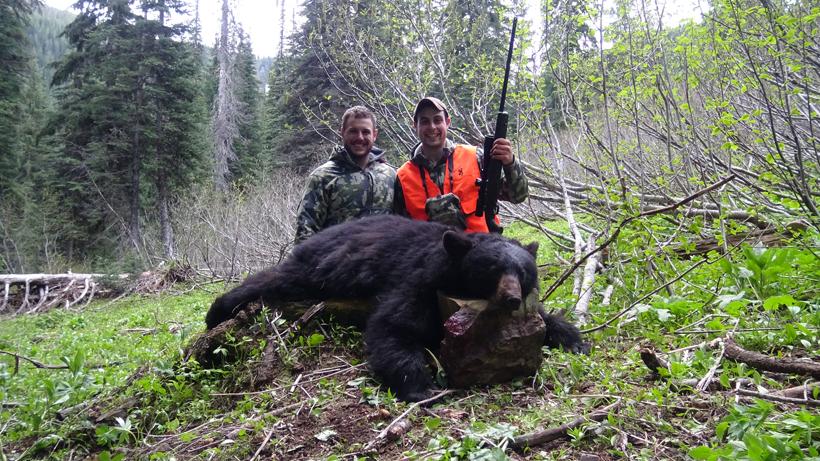
Jake Horton and his buddy tagged out on a nice bear. Photo credit: Jake Horton
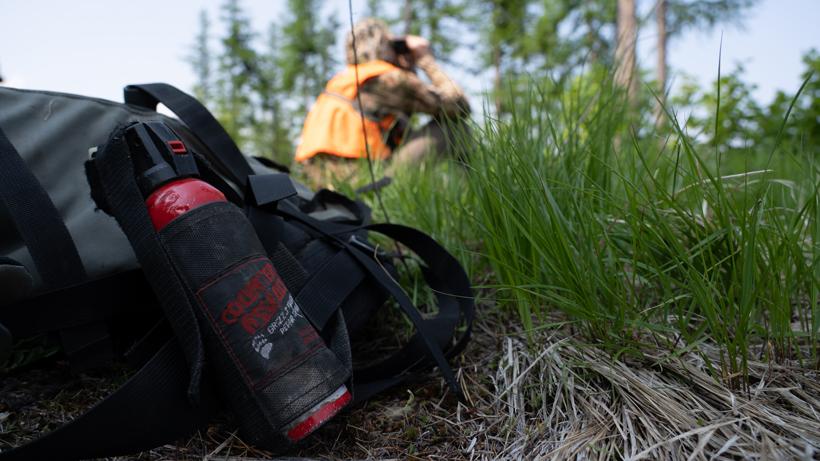

You know it’s springtime when the weather finally breaks and the sportsmen and women can finally get outside to enjoy hunting and fishing again. Whether we're shed hunting for elk or deer antlers, chasing those early morning gobbles, or fishing for wild trout in the icy cold mountain waters, we are still enjoying the great outdoors and everything Mother Nature has to offer. There is one hunting season that seems to get easily overlooked by hunters for a variety of reasons but is every bit as exciting as those sheds, gobblers or brook trout. What season am I talking about? Well, spring bear season, of course. Until recently, spring bear season seemed overly complicated with the chances of getting a bear nearly impossible; however, the truth is that the chances for success during your first year are really high. You can figure out excellent spots and see bears nearly every day. You can do this hunt on a limited budget and this hunt is my most enjoyable and stress-free hunt of the year. With some preparation, time off, and a good long-range rifle, spring bear season can be something you look forward to every year.
In my opinion, the best states to hunt for spring black bears are Idaho, Montana and Wyoming. Yes, there are a lot more western states that allow you to hunt black bears in the spring, but, let's face it: you have a limited amount of time, so why not go where the bear numbers are highest. You may be wondering why bear numbers are so high in these states. Well, that’s because these states have some of the nastiest, steepest, thickest country that exists in the United States and bears thrive in this environment. Idaho, Montana and Wyoming have over-the-counter (OTC) bear tags for specific units. Wyoming is the only one out of these states with a specific quota of bears that can be harvested in each specific unit and this information is available daily. Hunters can strategically use goHUNT to see what units offer OTC spring bear tags and how many bears are harvested annually. Honestly, if you go bear hunting in any of these areas and hunt hard you will have a good opportunity of seeing a bear and getting close enough for a shot during a five-day hunt.
Once you pick a state, get an INSIDER membership and cut some major time out of your scouting. Most people are very familiar with the benefits of using goHUNT’s INSIDER platform for determining where to spend their mule deer or elk points; however, the information compiled on other species like black bears is top-notch.
Screenshot from GOHUNT's Filtering 2.0 showing the number of bears harvested in Montana.
On the GOHUNT INSIDER platform on Filtering, you can simply search Idaho, Montana, Wyoming or any other state by OTC Spring Back Bear Season, then search by number of bears killed and you’ll see the top bear harvest units. This information coupled with the amount of public land can allow you to pick a unit where you find bears and have a chance at killing one — usually within less than 10 minutes of research on GOHUNT’s site. It honestly doesn’t get any easier than that and as an INSIDER member myself, I would highly recommend it.
Below you'll find some quick links to GOHUNT's Filtering 2.0 to find OTC black bear hunts.
Once you have a unit or two picked out in the state of your choice, you should make some calls to the local forest service rangers, game wardens, and other local officials to determine when the bears typically come out of hibernation, what roads will be open during the spring season due to snow closures, and confirm that there are good bear numbers there. Typically, these local officials are very aware of the bear density in their area because of camper, hiker and backpacker reports. If they say there are a lot of bear sightings and the GOHUNT harvest numbers are good, then it is time to start some online satellite scouting.
Before we get into the nitty-gritty of where, when and how, it's important to talk about bears’ spring behavior. In the springtime, bears naturally come out of hibernation between March and June, depending on the snow line and weather. Every year will be different; however, you can bet that the lower in elevation a bear is hibernating, then the sooner they will typically awake. As soon as a bear wakes up from their winter slumber, they immediately seek out food. The easiest food for these omnivorous mammals to get are new blossoms, flowers, berries, tree buds, bugs, grubs and anything in between. Bears tend to live and hibernate in the dense forest, but usually after waking from their hibernation, they are drawn to any open hillside facing south. These southern hillsides typically have the snow melted off by the time a bear wakes and has already turned green and lush with small plants and buzzing with bug activity. Surprisingly, at high elevations, plant life tends to sprout and bloom at an increased speed compared to lower elevation plant life, which actually leads to a greater amount of protein for a bear to consume. Keeping all of this in mind, it is time to begin your online scouting and plan out some spots to sit for your hunt.
Online scouting can be super beneficial during spring bear season in order to drastically increase your odds of spotting and harvesting a bear. Start by finding a reliable satellite imagery website with up-to-date images within the last five years. Google Earth or maps provided on state websites are excellent resources. Then, search within dense forest a mile or two from trails and roads and mark any open parks, two to five- year-old burns, avalanche shoots, controlled logging areas or obvious logging roads that are grown up and green. The next step is to see if there is a place to spot and shoot from within a decent distance from the bear feeding habitat. These potential shooting points can be either across, above or below the location where a bear may appear while hunting. If there is not a shooting area within my rifle’s range, then the spot is not a good one. Personally, I determine this by using Google Earth and using the measurement tool to see how far the potential shot would be. With practice and good ammo, an average rifle today can shoot out to 400 yards give or take. A long-range rifle can shoot much farther — even up to 600 to 700 yards for a skilled marksman. However, while scouting and hunting, it is important to be honest with yourself about your rifle and your skill. It does you no good to hike back off the trail multiple miles and see a bear that is 2,000 yards away across a valley and not be able to take the shot or get any closer. It is equally as bad to attempt to take a shot that is too far for you or your rifle and end up wounding one of these animals.
In my experience scouting, for every 20 perfect bear spots, I find in a unit only one has an opening to shoot from that I can make with my rifle. Keeping that in mind, if a spot is not perfect, move on and find another. Places like Idaho, Montana and Wyoming seem to have endless open south facing areas if you look closely. It’s also important to note the elevation of the spots you are scouting and planning to hunt. I like to pick multiple hunting spots for every 1,000’ in elevation change from 7,000’ to 12,000’. Depending on when you are hunting and what the winter was like that year, bears can come out of hibernation at different times of the spring, putting them in open areas at different times. The last thing you want is to come out to Idaho and plan to hunt bears at 10,000’ to find out that they are all under 3’ of snow still in the middle of May.
Jake Horton and his buddy tagged out on a nice bear. Photo credit: Jake Horton
After you have found some good spots and entered them into your GPS, take some days off of work and go after some bears. Bears are typically out and about at first and last light so you need to be at your shooting point for the first few hours of the morning and the last few hours of the day. Other than that, the rest of the day is yours to plan, which is why I feel that bear hunting is way less stressful than other hunts that keep you on your feet and pushing all day long. Plan for a morning and evening hunt and maybe some fishing during the middle of the day. If you are deep in bivy camping, days can be long so bring a hunting buddy or two along to help pass the time and to help you pack out when you finally pull the trigger. During the spring, bears can habitually feed in the same area for a few days to weeks in a row so I would typically give a specific spot one to two sits before moving on to a different hunting spot. This also keeps your morale up and allows you to see more beautiful spring country. If you are successful and harvest a bear, make sure to have a plan to get it out. Though sometimes it gets a bad reputation, bear meat is actually quite good, especially if made into some sausage.
It should go without saying; however, it is important to note that bears are predators and can be very dangerous to any humans entering their habitat. By themselves, black bears typically will run away from humans at their first smell or confirmed sighting of us, but that is not always the case. If you startle a bear or come across one with cubs, they can easily have a fight mentality. When it comes to black bears, the National Park Service recommends you DO NOT PLAY DEAD. They recommend that you fight the bear back by kicking or punching the bear in the muzzle. Once the bear backs off and goes out of sight, vacate the area immediately. Many of the prime bear hunting areas in Idaho, Montana and Wyoming also have grizzly bears. Though the grizzly numbers are fewer than black bears, they are less likely to run away from you as they feel they are the dominant predator. If attacked by a grizzly bear, the National Parks Service recommends you leave. Do not drop your hiking pack in order to protect your back, then lay on your stomach and spread your arms and legs to prevent the bear from flipping you off your back and PLAY DEAD. Hopefully, the grizzly bear will lose interest and leave; however, if the attack continues and the bear is not losing interest, fight back as hard as you can and hit the bear with anything you have.
In general, bear attacks are rare; however, they do happen so don’t be afraid to talk out loud on your way in to your morning spot until you get close, carry bear spray, firearms or a quick access knife. When camping, store your food away from your camp suspended in the air between two trees. Bears can climb trees so putting it up in the air, leaning on a tree will only delay the inevitable. Pack in food that doesn’t smell through the packaging and clean up after you eat. Bears are incredible animals and hunting them can be the biggest excitement of your year, but be sure to do it safely. If you have any questions or concerns, feel free to reach out to me in the comments below. Good luck this spring!